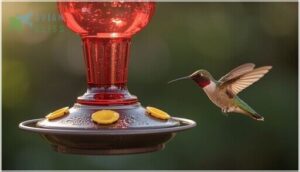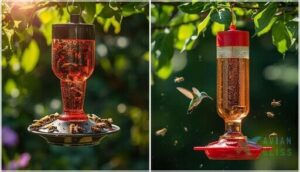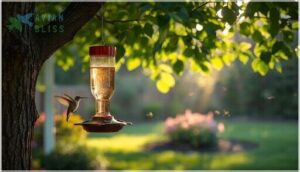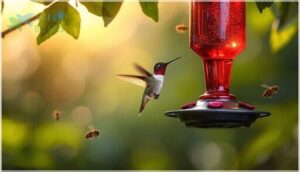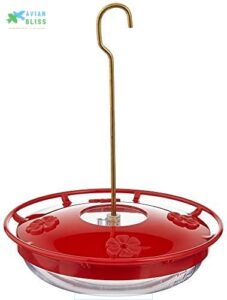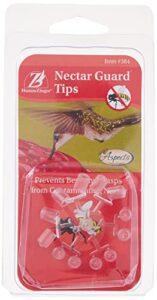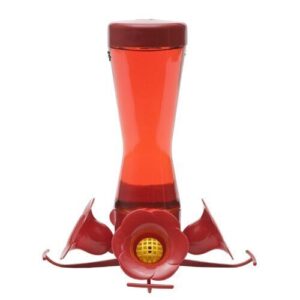This site is supported by our readers. We may earn a commission, at no cost to you, if you purchase through links.
You fill your hummingbird feeder with fresh sugar water, hang it in the perfect spot, and wait for those iridescent visitors to arrive. Within hours, though, a different crowd shows up: honeybees, wasps, and yellow jackets swarming the ports and driving away the very birds you’re trying to attract.
This frustrating scenario plays out in backyards across the country because bees have a remarkable ability to detect sugar sources from impressive distances, and once they find your feeder, they recruit their entire colony through chemical signals and waggle dances.
The good news is that you don’t have to choose between feeding hummingbirds and managing bee invasions—simple adjustments to your feeder design, placement, and maintenance routine can create an environment that welcomes hummingbirds while naturally discouraging bees from taking over.
Table Of Contents
- Key Takeaways
- Why Bees Are Attracted to Hummingbird Feeders
- Choosing and Placing Bee-Resistant Feeders
- Effective Strategies to Keep Bees Away
- Top 5 Products to Deter Bees From Feeders
- Frequently Asked Questions (FAQs)
- What scent keeps bees away?
- Why are bees covering my hummingbird feeder?
- How do you keep bees away from hummingbird feeders?
- Do you keep bees and wasps away from your hummingbird feeder?
- How do you keep hummingbirds away from your feeder?
- How to attract hummingbirds away from bees?
- How do I make my hummingbird feeder bee proof?
- Why is my hummingbird feeder attracting bees?
- Will Vicks keep bees away from hummingbird feeders?
- Can red food coloring harm hummingbirds?
- Conclusion
Key Takeaways
- You can stop bees from taking over your hummingbird feeder by choosing red, dish-style designs with built-in bee guards and placing them in shaded spots at least 10 feet from flower beds.
- Diluting your sugar water to a 1:5 ratio and cleaning your feeder weekly prevents the sticky residue and fermentation that acts like a neon sign for bees while still keeping hummingbirds happy.
- Moving your feeder just 4 feet every few days disrupts the chemical maps bees use to navigate, while hummingbirds adapt quickly and find the new location without trouble.
- Setting up decoy feeders with richer sugar solutions (2:1 ratio) and planting bee-friendly flowers like bee balm 10-15 feet away redirects foraging traffic and creates separate feeding zones for both pollinators and hummingbirds.
Why Bees Are Attracted to Hummingbird Feeders
You’ve hung up a feeder to enjoy those tiny aerial acrobats, but suddenly you’re dealing with a swarm of bees instead. Understanding why bees zero in on your hummingbird feeder is the first step to solving the problem.
Let’s look at what draws these insects to your yard and how their behavior affects the hummingbirds you’re trying to attract.
Bee and Wasp Behavior Around Feeders
When bees discover your feeder, their social recruitment dynamics kick in fast—one scout brings the whole hive. They’re drawn by sugar source motivation and visual cue preference, especially if you’ve got yellow parts. Wasps show similar behavior, exploiting access points through leaks or drips.
Many feeders now incorporate effective bee guards to mitigate this issue. This swarming creates a real hummingbird feeding impact, crowding out the birds you’re trying to attract and turning bee and hummingbird interactions competitive.
The Role of Nectar and Sugar Water
Nectar composition matters more than you might think. Sugar concentration drives bee attraction—the sweeter your solution, the more bees you’ll see. Field data shows hummingbird-pollinated flowers average 20–25% sugar by weight, matching a standard 4:1 water-to-sugar ratio.
Bees routinely forage at these concentrations, but they’ll crowd even harder around richer mixtures. Diluting your sugar solution to 5:1 lowers the payoff enough to discourage some bee traffic while still supporting hummingbirds. A suitable mixture is one part sugar to four parts water for most conditions.
How Feeder Color and Design Impact Bee Attraction
Color preference matters because bees see differently than hummingbirds. Yellow feeders act like neon signs to bees, while red appears dim to their vision. Feeder design choices directly control access:
- Port size around 6 mm blocks most insects while admitting hummingbird bills
- Dish-style reservoirs keep nectar below reach of short bee tongues
- Leak prevention eliminates sugar films that recruit swarms
- UV-dull surfaces reduce the high-contrast signals bees use to find flowers
Choose feeders with small, tight ports and skip any yellow accents.
Impact of Bee Swarms on Hummingbirds
When ports and colors work against you, the consequences ripple far beyond mere inconvenience. Research shows hummingbirds skip 72% of feeding opportunities when wasps claim the feeder. Bees drain nectar faster than you can refill it, forcing birds to burn precious energy searching elsewhere. Wasps occasionally sting visitors, and contamination from insect traffic spreads disease—managing bee populations protects both your feeder investment and the hummingbirds depending on it.
Bee swarms don’t just annoy—they drain feeders, chase away 72% of hummingbird visits, and spread disease that threatens the birds you’re trying to protect
| Impact | What Happens |
|---|---|
| Nectar Depletion | Bees empty feeders before hummingbirds arrive |
| Foraging Changes | Birds abandon infested sites for natural flowers |
| Aggressive Interactions | Wasps chase hummingbirds, creating territorial zones |
| Injury Risk | Stings and collision hazards near dense swarms |
| Disease Spread | Insect contamination accelerates mold and bacteria growth |
Choosing and Placing Bee-Resistant Feeders
The right feeder can make all the difference when you’re trying to keep bees at bay while still welcoming hummingbirds. Design features, color choices, and where you place your feeder all work together to create a space that’s friendly for hummers but less appealing to bees.
Let’s look at the key features and placement strategies that’ll help you reclaim your feeder for the birds you actually want to attract.
Selecting Feeders With Bee Guards and Ant Moats
When you’re choosing your next feeder, look for integrated designs with built-in bee guards and an ant moat. Bee guards position nectar ports 10–15 mm deep, blocking bee access while hummingbirds feed easily. Ant moats create a water barrier that stops crawling insects.
Check that port placement recesses nectar and feeder material prevents leaks. Proper guard effectiveness depends on moat maintenance—refill water every few days to keep your hummingbird feeder design preventing bee access reliably.
Dish Vs. Gravity-fed Feeder Designs
Between the two main styles, gravity-fed feeders keep nectar several centimeters below the port—beyond bee reach—while saucer-shaped hummingbird feeders or dish feeder designs expose liquid within millimeters of the surface. That shallow nectar exposure amplifies scent cues, pulling in swarms.
Bottle feeder models seal the reservoir, preventing bee access far more reliably. Cleaning ease favors dishes, yet placement advice consistently recommends gravity-fed designs near patios to minimize insect crowds.
Best Feeder Colors to Deter Bees
Beyond shape, feeder materials and paint choices play a surprising role in bee vision. Bees see blue, yellow, and UV reflection most clearly, so avoiding bright colors like yellow on ports cuts attraction sharply. Red feeders work best—bees can’t detect wavelengths above about 650 nm, making red nearly invisible to them.
Choose designs with:
- Solid red or burgundy bases
- Minimal white or yellow accents
- Nontoxic paint to protect birds
Color contrast matters less to bees when red dominates your hummingbird feeder design.
Optimal Feeder Placement to Minimize Bees
Where you hang your feeder shapes the entire experience. Shade exposure dramatically cuts bee visits—insects prefer sunny, warm spots, so relocating hummingbird feeders under eaves or branches works wonders. Distance from resources matters too: keep feeders at least 10 feet from flower beds or seed stations. Vertical positioning around 8 feet dodges wasp patrol zones, while structure proximity and strategic feeder spacing confuse insect flight paths.
| Placement Factor | Recommended Action |
|---|---|
| Shade vs. Sun | Choose shaded areas to deter foraging insects |
| Distance from Flowers | Position 10–15 feet away from blooming plants |
| Height | Hang around 8 feet to avoid wasp patrol zones |
| Near Structures | Place 2–3 feet from walls to block insect paths |
| Relocation | Move 4–15 feet when bee activity increases |
Effective Strategies to Keep Bees Away
Once you’ve chosen the right feeder and placed it strategically, you’ll want to take a few extra steps to keep bees at bay. These proven techniques work together to make your feeder less appealing to insects while keeping hummingbirds happy and well-fed.
Let’s look at five practical strategies you can start using today.
Regular Feeder Cleaning and Leak Prevention
When nectar ferments and drips, you’re basically rolling out a welcome mat for bees. Regular cleaning—at least weekly, or every 2–3 days in hot weather—stops microbial growth and reduces the sticky residue that attracts insects. Proper feeder maintenance pays off:
- Use hot water or a vinegar solution to scrub ports and seams thoroughly
- Inspect gaskets and O-rings for wear that causes leaks
- Wipe exterior surfaces to remove sugary residues after each refill
Tight seals prevent the fermentation process that draws unwanted guests.
Using Less Sweet Nectar Mixtures
You can turn down the sweetness dial to make your feeder less inviting to bees. A standard 1:4 sugar-to-water ratio produces roughly 18–20% sugar—sweet enough for hummingbirds but less attractive to bees, which prefer concentrations above 30%.
In extreme heat, you can even stretch to 1:5 for extra hydration without losing hummingbird visitors, while bees lose interest in these lighter nectar dilutions.
Moving Feeders and Rotating Locations
Shifting your feeder’s location is like resetting the map for bees—they memorize fixed spots, while hummingbirds adapt quickly. Move your feeder about 4 feet laterally or adjust vertical placement within the 4–6 foot range every few days when bees swarm. Rotation frequency matters: relocate from sun to shade, space multiple feeders several feet apart, and alter feeder arrangement regularly to disrupt insect foraging patterns without losing your hummingbird visitors.
- Relocate feeders approximately 4 feet to reset bee foraging memory
- Rotate locations every few days when insect activity spikes
- Adjust vertical placement between 4–6 feet above ground
- Shift feeders from sun to shade to reduce bee preference
- Space multiple feeders apart and alternate active feeding sites
Providing Alternative Food Sources for Bees
You can draw bees away by setting up dedicated bee feeders filled with richer sugar solutions—bees favor concentrations around 52%, while hummingbirds prefer about 33%. Place decoy feeders at least 10 feet from your hummingbird stations to spatially separate foraging zones. During seasonal nectar dearths in late summer, maintain these alternative sources consistently to redirect insect traffic and restore balance in your yard.
| Strategy | Sugar Concentration | Placement Distance |
|---|---|---|
| Decoy Feeder Placement | 2:1 water-to-sugar (richer) | 10–15 feet from hummingbird feeders |
| Dedicated Bee Feeders | ~52% sugar solution | Adjacent to hives or open sunny areas |
| Bee Feeding Station | Honey water or fruit juice | 6+ feet from primary feeders |
| Seasonal Nectar Provisioning | Concentrated syrup during dearths | Near bee-friendly plants, away from patios |
Planting Bee-attractive Flowers Away From Feeders
Beyond decoy feeders, you can anchor bee activity in one corner of your yard by planting native bee plants like mountain mint, bee balm, and butterfly weed at least 10–15 feet from your hummingbird stations.
This spatial planting design channels foraging traffic toward distant bee gardens stocked with yellow and white blooms.
Stagger seasonal bloom times so attractive nectar sources stay available through summer, reducing competition at feeders.
Top 5 Products to Deter Bees From Feeders
You don’t have to fight bees empty-handed when dozens of well-designed products can tip the scales in your favor. The right feeder or accessory makes it harder for bees to reach the nectar while keeping things easy for hummingbirds.
Here are five standout options that can help you reclaim your feeders.
1. Aspects HummZinger HighView Hummingbird Feeder
If you’re serious about bee prevention, the Aspects HummZinger HighView hummingbird feeder brings together Design Features that actually work. This 12-ounce dish-style feeder keeps nectar below the feeding ports, making it difficult for bees to reach. The built-in ant moat addresses crawling insects, while the drip-proof construction prevents sticky spills that attract swarms.
Material Durability is excellent—UV-stabilized polycarbonate withstands weather without cracking.
Maintenance Ease shines with the wide-mouth design that lets you scrub every corner.
For serious Insect Deterrence, you can add optional bee guards to create a nearly bee-proof feeding station.
Best For: People who want a reliable hummingbird feeder that keeps bees and wasps away without constant maintenance hassles.
- Dish-style design with recessed ports makes it tough for bees to reach the nectar, and you can add bee guards for even better protection
- Built-in ant moat stops crawling insects, while the drip-proof construction prevents the sticky messes that usually attract swarms
- Wide-mouth opening makes cleaning simple—you can actually scrub every corner without fighting with narrow bottle necks
- The price point might feel steep compared to basic feeders, especially if you’re just testing the hummingbird-feeding waters
- You need to fill it to the 8-ounce mark to keep bees from reaching the liquid, so you can’t use the full 12-ounce capacity
- The lid can crack if you push it down too hard during assembly or cleaning
2. Aspects Nectar Guard Tips Clear Two Inch
For tight bee prevention on compatible Aspects feeders, these nectar guard tips offer a straightforward upgrade. Each two-inch tip features a flexible crosshatched membrane that lets hummingbird bills pass through but blocks bees and wasps from reaching nectar. Installation is simple—slide them onto feeding ports in seconds.
At around $5.95 for a 12-pack, they’re cost-effective insect guards that maintain feeder compatibility with HummZinger models. You’ll need to clean them weekly during routine maintenance, but users report significant bee deterrent effectiveness without frustrating the hummingbirds you’re trying to attract.
Best For: Anyone with compatible Aspects feeders who’s tired of bees and wasps monopolizing their hummingbird nectar and wants an easy, affordable fix.
- Flexible membrane design effectively blocks bees and wasps while letting hummingbird bills through without issue
- Super affordable at around $5.95 for a 12-pack, so you can outfit multiple feeding ports without breaking the bank
- Quick slide-on installation requires no tools or complicated setup
- Only fits specific Aspects feeder models with 1/4-inch ports, so they won’t work with other brands or larger port sizes
- Requires weekly cleaning to prevent nectar buildup and mold, adding to your maintenance routine
- Hummingbirds may need a few days to adjust to feeding through the membrane barrier
3. Perky Pet Pinch Waist Hummingbird Feeder
The PerkyPet Pinch Waist Hummingbird Feeder combines an eight-ounce glass bottle with four built-in bee guards that snap open for thorough cleaning. This design helps prevent bees hummingbird feeders attract while allowing hummingbirds easy access through longer bills.
You’ll want to clean it weekly—cleaning frequency directly impacts bee guard effectiveness and mold prevention. The nectar guards work well when maintained properly, though some users report nectar capacity issues from spills during filling.
The wide-mouth design simplifies maintenance, and user experience insights confirm fewer bee intrusions with consistent upkeep.
Best For: Anyone wanting a classic glass feeder that’s easy to clean and maintain, especially if you’re dealing with occasional bee problems and don’t mind weekly upkeep.
- The snap-open bee guards make cleaning way easier than most feeders, and they actually work when you keep them clean
- Eight-ounce glass bottle with wide mouth means you can get a brush in there and really scrub it out
- Four feeding ports handle multiple hummingbirds at once without too much squabbling
- You need to clean it weekly or the bee guards lose effectiveness and mold starts building up
- Some people have trouble with nectar spilling during fills, which just attracts more bees
- The eight-ounce capacity runs out pretty fast if you’ve got a lot of hummingbirds visiting
4. Heath Yellow Butterfly Bliss Feeder
The Heath Yellow Butterfly Bliss Feeder offers a multi-purpose approach with its steel frame and yellow glass dish design. Yellow color naturally deters bees compared to red feeders, while the dish accommodates bird seed or water instead of traditional nectar.
You won’t find built-in nectar guards or insect guards here, but the open design makes cleaning simple—preventing bees hummingbird feeders attract through residue buildup.
Market popularity remains steady due to its decorative appeal and versatility. Regular maintenance and strategic placement away from flowers best uses its effectiveness in keeping unwanted visitors at bay.
Best For: Gardeners who want a decorative feeder that naturally discourages bees through its yellow color while attracting birds and butterflies with versatile feeding options.
- Yellow glass design deters bees more effectively than traditional red feeders while still attracting birds and butterflies
- Multi-purpose functionality works as a bird feeder, butterfly feeder, or bird bath with easy-to-clean glass dish
- Simple open design prevents residue buildup and makes maintenance straightforward
- No built-in bee guards or nectar ports mean it doesn’t completely eliminate bee visits
- Some customers report durability issues with broken parts on arrival or hooks breaking after short-term use
- Requires regular maintenance and strategic placement away from flowers to maximize bee deterrence
5. Regal Yellow Birdbath Feeder Stake
The Regal Yellow Birdbath Feeder Stake uses bright yellow coloration that actually attracts bees rather than keeping bees away from hummingbird feeders—making it work as an effective bee decoy when placed strategically. This dual purpose stake functions as both birdbath and feeder, drawing pollinators to an alternative spot six feet from your nectar feeders.
Garden placement matters: position this yellow piece near bee-friendly flowers to redirect insects. Durability issues include a flimsy stand, but at $40 it offers a practical solution for preventing bees hummingbird feeders face without bee guards.
Best For: Gardeners who want to attract bees and pollinators away from hummingbird feeders by using the bright yellow color as a strategic decoy in their yard.
- Bright yellow sunflower design naturally attracts bees and wasps, making it an effective decoy when placed away from hummingbird nectar feeders
- Dual-purpose glass bowl works as either a birdbath or feeder, giving you flexibility in how you use it throughout the seasons
- Hand-painted artisan glass with decorative appeal adds visual interest to garden beds and flower borders
- Stand is flimsy and the base is poorly made according to multiple customer reports, raising durability concerns
- Yellow coloration works against you if placed too close to hummingbird feeders, as it will attract more bees to the area rather than redirect them
- Glass bowl may fade in direct sunlight and can crack during freeze-thaw cycles, requiring seasonal removal or protection
Frequently Asked Questions (FAQs)
What scent keeps bees away?
Peppermint, eucalyptus, and citrus essential oils effectively repel bees, reducing visits by 50–60%.
These natural pest control solutions work as bee deterrent solutions without harming pollinators, offering safe insect repellent options when applied consistently around outdoor spaces.
Why are bees covering my hummingbird feeder?
Your feeder’s basically running an all-you-can-eat buffet. Bees swarm it because the sugar water mimics flower nectar—an easy food source they’ll defend aggressively, especially during peak bee season when hot weather limits natural options.
How do you keep bees away from hummingbird feeders?
You can keep bees away by using red feeders with bee guards, diluting nectar to a 1:4 sugar-water ratio, and placing feeders in shade.
Additionally, planting bee-attractive flowers elsewhere can help redirect foraging activity.
Do you keep bees and wasps away from your hummingbird feeder?
Like trying to hold back a tide with a rake, bee control demands multiple integrated pest management tactics—smart nectar concentration impact, strategic hummingbird feeder defense, and bee deterrent methods working together to protect your feeders from persistent bees and wasps.
How do you keep hummingbirds away from your feeder?
Actually, you shouldn’t keep hummingbirds away—protecting hummingbird feeders means deterring bees while welcoming birds.
Use nectar dilution, feeder relocation, visual deterrents, alternative feeders, or temporary removal to manage insects without discouraging hummingbirds.
How to attract hummingbirds away from bees?
You can draw hummingbirds to cleaner feeders by offering standard nectar concentration, using red color cues, and providing alternate nectar feeding sites for bees.
Simultaneously attracting hummingbirds while habitat management reduces bee interference through strategic feeder design.
How do I make my hummingbird feeder bee proof?
You can bee-proof your hummingbird feeder by choosing saucer-style designs with built-in bee guards and nectar guard tips.
These physical barriers prevent bees from accessing the nectar while letting hummingbirds feed freely.
Why is my hummingbird feeder attracting bees?
Your feeder attracts thousands of bees because sugar water mimics floral nectar concentration they crave.
Leaky feeders, bee scouting behavior, seasonal factors, and massive colony size during peak foraging periods make hummingbird feeders irresistible targets for attracting unwanted insects.
Will Vicks keep bees away from hummingbird feeders?
No peer-reviewed studies confirm Vicks VapoRub’s effectiveness at hummingbird feeders. Anecdotal evidence suggests short-term repellency, but essential oil alternatives and proven bee-resistant feeder designs offer safer, more reliable bee control methods without risking hummingbird safety.
Can red food coloring harm hummingbirds?
Yes, red dye poses potential harm. Cornell Lab and Audubon advise against adding red food coloring to nectar since hummingbirds consume far more dye than humans relative to body weight, and no safety studies exist for birds.
Conclusion
The next time you spot a lone bee circling your feeder, you’ll know exactly what it signals—and how to act before the entire hive shows up. Mastering how to keep bees away from your hummingbird feeders transforms your backyard from a battleground into a peaceful refuge where those jeweled wings finally claim their rightful place.
With the right feeder design and a few strategic adjustments, you’re creating space where both pollinators and hummingbirds can thrive without competing for the same resource.
- https://www.hummingbirdsociety.org/post/how-to-keep-bees-wasps-and-ants-out-of-your-hummingbird-feeders
- https://green-backyard.com/blogs/how-to-keep-bees-away-from-hummingbird-feeders/
- https://ask.extension.org/kb/faq.php?id=915728
- https://www.colonialpest.com/2016/08/15/can-keep-yellowjackets-off-hummingbird-feeders/
- https://northasheville.wbu.com/hummingbird-nectar-information-guidelines


